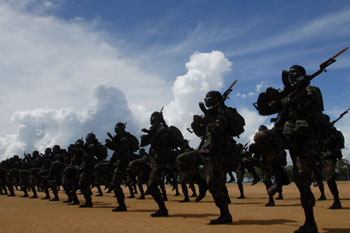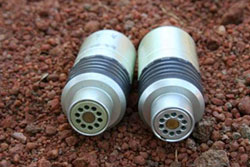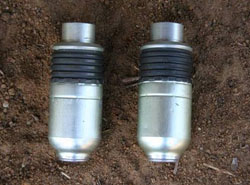Weeks ago, troop carrier Jetliner was heading to Trincomalee from Kankesanthurai (KKS) with a complement of some 2200 officers and men.
They had begun the voyage at 1 p.m. from KKS and were only some two hours away from the Navy's eastern area headquarters in the Dockyard. They were some 30 nautical miles off the coast in the general area of Kokkutuduwai. There was no air cover at that point though combat aircraft operating in the area were only seconds away in an emergency.
Just after 5 p.m., officers on the upper deck saw a suspicious aircraft high above in the sky. It was a cloudy day and visibility was somewhat restricted. Occasionally the aircraft, which looked like a speck in the sky due to the high altitude, disappeared into the clouds only to re-appear again. The height made identification difficult. Soon fears grew that it could be a Tiger guerrilla aircraft preparing to drop bombs. This was after it came directly over the troop carrier.
 |
| Air Force recruits who passed out from a combat training course to become regimental airmen at a drill display in Trincomalee yesterday. The Commander of the Air Force Air Marshal Roshan Gunathilake was the chief guest. Photo: Sanka Vidanagama |
Misssile systems were activated. Within moments, alert sentries on board the vessel did not want to take a chance. They began firing their 12.5 m.m. guns into the sky. Those staffing GPMGs (General Purpose Machine Gun) also opened up. For a few minutes, the burst of gunfire became deafening and led to confusion among soldiers who were in the lower decks. It stopped only after an Air Force officer, assigned to Jetliner ordered them to cease firing. He had checked on the radio with the Air Force and had been told that the suspicious aircraft was an SLAF Beechcraft. This fully-equipped surveillance aircraft was, among other matters, monitoring the movements of the troop carrier.
Thus, the tense moments for the officers and men on board, heading home on leave ended. Last month, the message of an impending guerrilla air attack led to lights at hospitals housing injured troops in Anurahdapura being blacked out. It turned out to be a false alarm. Last Tuesday, Government leaders passed down to the military information of a major ground attack being planned on an unidentified security installation. Independent information had also arrived later from a service arm after a radio intercept. All military installations in the north and east were placed on high alert. However, there was no such attack.
Nevertheless tense moments for a larger number of troops continued as battles raged on a number of fronts in the Wanni. Inland from the shores, not far off from where the Jetliner sailed, troops in the Weli Oya sector have regained control of more territory. This is west of the village of Andankulam, which they re-captured earlier and positioning themselves on the outer fringes of the Nayaru lagoon. However, troops are yet to reach the guerrilla fortifications on their defences far south of Mullaitivu.
Army officials in Weli Oya say "Col. Sornam," the guerrilla leader responsible for countering the troop advance in this sector, has ordered the arrest of cadres who had deserted ranks. Some of them who have been taken in are now deployed in battle areas, they say.
Troops of Task Force 1, operating in the landmass adjunct to the western coast near Nachchikuda, have skirted around this village, to re-capture more territory. This is on the A-32 Mannar-Pooneryn road between the villages of Jayapuram and Vannierikulam. Though troops are yet to enter Nachchikuda, once a major Sea Tiger base, this coastal village is somewhat isolated with troops seizing areas northeast of it. In this sector, troops have moved beyond a lengthy bund the guerrillas had constructed.
However, troops at Akkarayan still remain on the outer fringes of the Kokavil junction located on the A-9 highway. Here, the only significant development in the past weeks has been the troop advance northwards, some three kilometres from their positions at Akkarayan. Yesterday troops in Akkarayan fought fierce battles with guerrillas. It came as they advanced some one and half kilometres. This was at a location west of Akkarayan where positions held by the Army’s Task Force 1 and the 57 Division converged. Both sides suffered heavy casualties. Troops are still some 16 kilometres away from Kilinochchi. Away from the troops' positions across the A-9 highway, the Army has learnt that the guerrillas had built another large bund to halt a troop advance in the direction of Iranamadu and beyond. It is said to be an "L" shaped one ahead of the irrigation tanks. A few kilometres southwest of this area lay the LTTE's largest airstrip.
Intelligence sources say LTTE leader Velupillai Prabhakaran, visited some of the displaced families living in makeshift structures in the Mullaitivu district. He is also said to have addressed his senior cadres last week. Viswamadu, which was to encompass a ten square kilometre Demilitarized Zone (DMZ) the Government proposed together with Odusuddan, has now become a hive of guerrilla activity. Besides their camps, an office to oversee civilian activity including the issue of passes for their movement has been sited there.
Tiger guerrillas on the Akkarayan sector have been offering stiff resistance and have resorted to increased use of gas. It is said to be fired from a launcher and had also been used when 120 m.m. mortars were directed at troop positions. The guerrillas this week accused the Army also of using a "tear gas" type of gas but a high-ranking military source dismissed it as "just propaganda."
Troops affected by it have complained of breathing difficulties, vomiting and skin rash. According to the Army, the gas canisters (See photograph of unexploded canisters recovered from the battle area) contained CS gas. According to Wikipidia, the free encyclopaedia on the internet, CS gas (common name 2-chlorobenzalmalononitrile) is a substance that is used as a riot control agent and is generally accepted as being non-lethal. CS was discovered by two Americans Ben Corson and Roger Staughton at Middlebury College in 1928, and the chemical gets its name from the first letters of the scientists' surnames.
 |
 |
| Gas canisters used by Tiger guerrillas. The Army says they contain CS gas. |
The chemical, according to Wikipedia, reacts with moisture on the skin and in the eye causing a burning sensation and the immediate forceful and uncontrollable shutting of the eyes. It says reported effects could include tears streaming from the eyes, running nose full of mucous, burning in the nose and throat areas, disorientation, dizziness and restricted breathing. In highly concentrated doses it can also induce severe coughing and vomiting. Almost all of the immediate effects wear off in a matter of minutes, it adds.
The use of CS in war, the internet encyclopaedia says, is prohibited under the terms of the 1997 Chemical Weapons Convention (signed in 1993) because it could trigger retaliation with more toxic agents such as nerve gas. Domestic police use of CS, however, is legal in many countries. Recently, blank pistol cartridges carrying CS in powder form have been released to the public. These, when fired in relatively close ranges, fully expose the target to the effect of CS, and is employed as a potent defensive weapon in regions where blank firing pistols are legally permitted for such use, says Wikipedia.
It adds that Saddam Hussein used CS against Kurds in his own country and against Iran during the Iran-Iraq war. Blackwater Worldwide, acting as an agent of the United States, deployed the CS in Iraq war from a helicopter hovering over a checkpoint in Green Zone in Baghdad. The British Army and the Royal Ulster Constabulary (RUC) had used it in Northern Ireland, according to Wikipedia. It adds that thousands of tons of CS gas were used by US forces in Vietnam to bring Viet Cong to the open and points out that according to other estimates 15 million pounds of CS was used.
It also says that the Canadian, Norwegian and Australian armies train their soldiers with CS gas in a manner similar to that of the USA, as it is base part of NBC (nuclear, biological, chemical) or more recently within NATO CBRN (Chemical, Biological, Radiological, Nuclear) training.
First indication to Sri Lankan authorities that the Liberation Tigers of Tamil Eelam (LTTE) were planning to use gas emerged following a report by the US Federal Bureau of Investigation. A Tiger guerrilla weapons procurer, Thirunavukarasu Varatharasa, arrested in the US in September 2006 provided the FBI with a list of items which included 300 gas masks. Also arrested together were three Indonesians including an Army officer. Varatharasa and the Indonesians were convicted by the District Court of Maryland. Among other items, Varatharasa tried to procure from under cover FBI agents posing off as arms dealers were machine guns, sniper rifles, ammunition and surface to air missiles.
Interestingly, this arrest revealed that during the tenure of the Ceasefire Agreement of February 2002, the guerrillas were making preparations to broaden their offensive capabilities. However, Sri Lankan authorities were then unaware that the guerrillas had also procured large quantities of gas canisters.
Troops of the Army's 53 and 55 Divisions mounted an attack on guerrilla defence lines at Kilali this week. The move met with stiff guerrilla resistance. For reasons that are now obvious, further details cannot be discussed. In the wake of the ongoing offensives in the Wanni, security preparations in areas in key towns including the City of Colombo have been further heightened.
This is particularly in the wake of last week's abortive attempt by a guerrilla female suicide bomber to assassinate Agricultural Development Minister Maithripala Sirisena.
Police investigations into the incident have unearthed more details. The suicide bomber had accompanied an elderly cancer patient who had come to Colombo to obtain treatment. The patient had obtained the upstairs apartment of a house in Fernando Road, Wellawatte. Together with the patient and a close relative, she had registered at the Wellawatte police station. On that occasion she had produced a forged National Identity Card that bore the name Shanmugadas Gajamalini.
Another NIC in her possession gave her name as Wijesiri. The first part of the name in this forged card was burnt after she exploded herself.
Minister Sirisena escaped death when the suicide bomber exploded herself at the Pirivena Junction in Boralesgamuwa on October 9. He was returning after a ceremony in Bandaragama where a project to cultivate abandoned paddy land was inaugurated. Mr.Sirisena who travelled in a Mitsubishi Montero switched to a bullet proof BMW on his return journey. Instead, the explosion seriously injured Ranjit Wijetilleke, Secretary to the Agricultural Research Ministry.
It has now become known to the Police that the suicide bomber accompanied her handler and another accomplice to Bandaragama. This was after the duo, two males, had visited the Wellawatte apartment in the morning. The suicide bomber had travelled on the pillion of her handler's motorcycle whilst the accomplice was on his own one. Police are now investigating to ascertain whether she saw Minister Sirisena arrive in his vehicle.
Later, as she lay in wait at Boralesgamuwa, the handler had tipped her off about the returning convoy. Police are also trying to ascertain at which point she boarded a three-wheeler scooter taxi to arrive at Boralesgamuwa.
In the Wanni the northeast monsoon is now in full swing flooding many areas. This has, to a considerable degree, besides resistance from guerrillas, slowed down troop advance. But the troops are determined to forge ahead. Thus, hopes both in the military and among Sri Lankans of the re-capture of Kilinochchi in the coming days or weeks, like in the past two months, continue to rise. |




